The Trials & Hanging
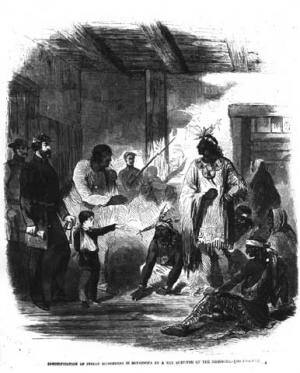 "The trials of the Dakota were conducted unfairly in a variety of ways. The evidence was sparse, the tribunal was biased, the defendants were unrepresented in unfamiliar proceedings conducted in a foreign language, and authority for convening the tribunal was lacking. More fundamentally, neither the Military Commission nor the reviewing authorities recognized that they were dealing with the aftermath of a war fought with a sovereign nation and that the men who surrendered were entitled to treatment in accordance with that status."
"The trials of the Dakota were conducted unfairly in a variety of ways. The evidence was sparse, the tribunal was biased, the defendants were unrepresented in unfamiliar proceedings conducted in a foreign language, and authority for convening the tribunal was lacking. More fundamentally, neither the Military Commission nor the reviewing authorities recognized that they were dealing with the aftermath of a war fought with a sovereign nation and that the men who surrendered were entitled to treatment in accordance with that status."
Carol Chomsky, Associate Professor, University of Minnesota Law School
On September 28, 1862, two days after the surrender at Camp Release, a commission of military officers established by Henry Sibley began trying Dakota men accused of participating in the war. Several weeks later the trials were moved to the Lower Agency, where they were held in one of the only buildings left standing, trader François LaBathe’s summer kitchen.
Theme:
1862Permissions beyond the scope of this license may be available at Copyright and Use Information.
Bibliography
Brown, Dee Alexander. Bury My Heart at Wounded Knee: An Indian History of the American West. New York: Holt, Rinehart & Winston, 1971.
Heard, Isaac V. D. History of the Sioux War and Massacres of 1862 and 1863. New York: Harper & Brothers, 1863.
Meyer, Roy Willard. History of the Santee Sioux; United States Indian Policy on Trial. Lincoln: University of Nebraska, 1993.
Resources for Further Research
Primary
Heard, Isaac V. D. History of the Sioux War and Massacres of 1862 and 1863. New York: Harper & Brothers, 1863.
Isch, John. The Dakota Trials: The 1862-1864 Military Commission Trials : Including the Trial Transcripts and Commentary. New Ulm, MN: Brown County Historical Society, 2012.
Secondary
Brown, Dee Alexander. Bury My Heart at Wounded Knee: An Indian History of the American West. New York: Holt, Rinehart & Winston, 1971.
Chomsky, Carol. The United States-Dakota War Trials: A Study in Military Injustice. Stanford Law Review, November, 1990.
Meyer, Roy Willard. History of the Santee Sioux; United States Indian Policy on Trial. Lincoln: University of Nebraska, 1993.
Related Images
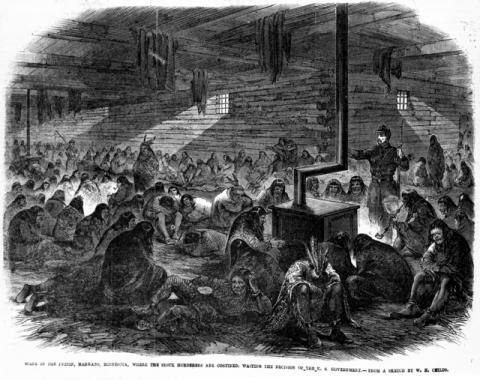
Scene in Prison
A scene in the prison where Dakota awaited the U.S. government's decision.
Source: Frank Leslie's Illustrated Newspaper, January 31, 1863, page 300.
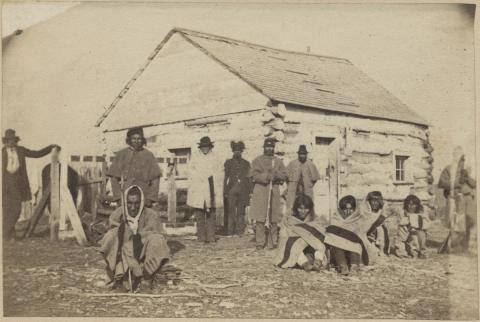
LaBathe Cabin
Adrian Ebell took this photo in 1862 of Dakota prisoners outside of the summer kitchen of François LaBathe. The cabin was used by Sibley's Military Commission as a courtroom for conducting trials of the accused.
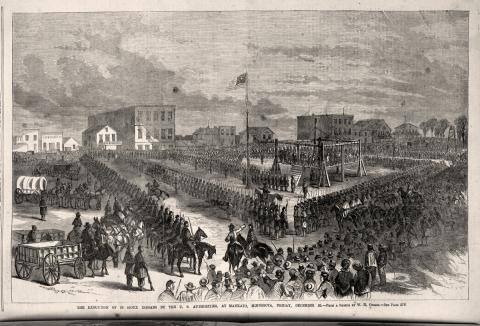
Execution of the Thirty-Eight Sioux Indians at Mankato
A drawing depicting the execution of 38 Dakota men in Mankato by Michael Nowack, 1862

Execution2
Copied from a sketch by Mr. Herman, of St. Paul.in Harper's Weekly, January 17, 1863, page 39. Title from Harper's Weekly.
Related Documents
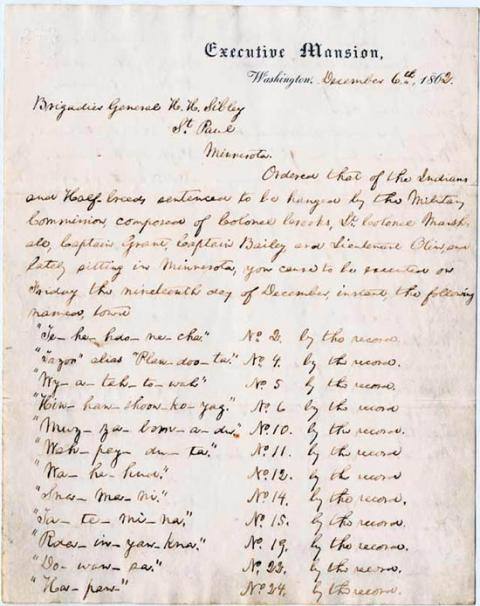
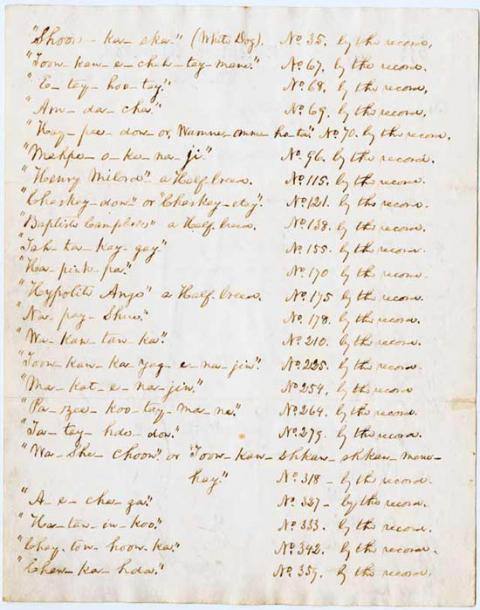
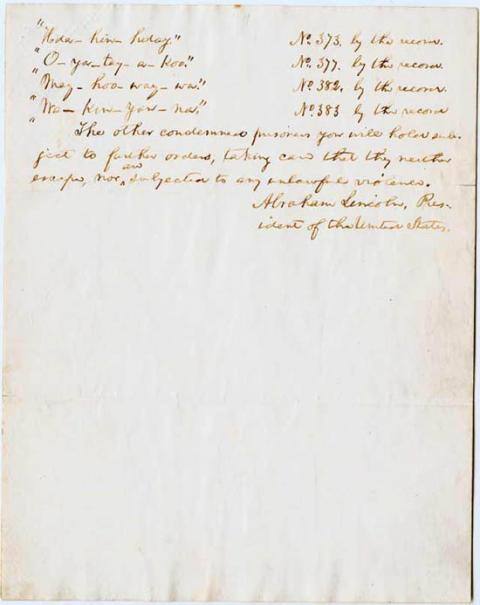
Lincoln's Execution List
On November 8, after completing harried trials of Dakota prisoners taken after their surrender at Camp Release, Henry Sibley presented the list of 303 condemned Dakota men to the US government.
Two days later, President Lincoln wired Gen. John Pope, Sibley’s superior: “Please forward, as soon as possible, the full and complete record of these convictions.”
Lincoln and his lawyers then reviewed the trial transcripts of all 303 men. “Anxious to not act with so much clemency as to encourage another outbreak on one hand,” Lincoln explained to the US Senate, “nor with so much severity as to be real cruelty on the other, I ordered a careful examination of the records of the trials to be made, in view of first ordering the execution of such as had been proved guilty of violating females.” When only two men were found guilty of rape, Lincoln expanded the criteria to include those who had participated in “massacres” of civilians rather than “battles.” He then made his final decision, and forwarded a list of 39 names to Sibley.
Ordered that of the Indians and Half-breeds sentenced to be hanged by the military commission, composed of Colonel Crooks, Lt. Colonel Marshall, Captain Grant, Captain Bailey, and Lieutenant Olin, and lately sitting in Minnesota, you cause to be executed on Friday the nineteenth day of December, instant, the following names, to wit [39 names listed by case number of record: cases 2, 4, 5, 6, 10, 11, 12, 14, 15, 19, 22, 24, 35, 67, 68, 69, 70, 96, 115, 121, 138, 155, 170, 175, 178, 210, 225, 254, 264, 279, 318, 327, 333, 342, 359, 373, 377, 382, 383]. The other condemned prisoners you will hold subject to further orders, taking care that they neither escape, nor are subjected to any unlawful violence. Abraham Lincoln, President of the United States
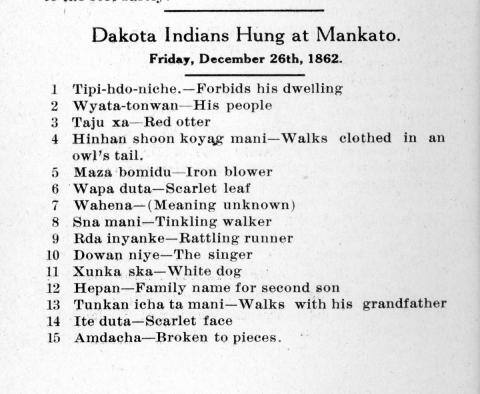
Mankato List
List of Dakota names from Marion Satterlee, A Detailed Account of the Massacre by the Dakota Indians of Minnesota in 1862 (1923)
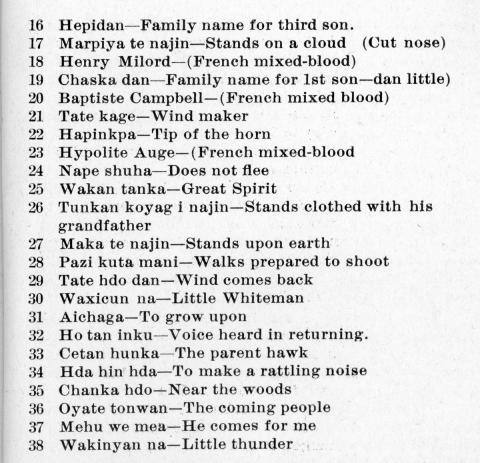
Mankato List2
n/a
